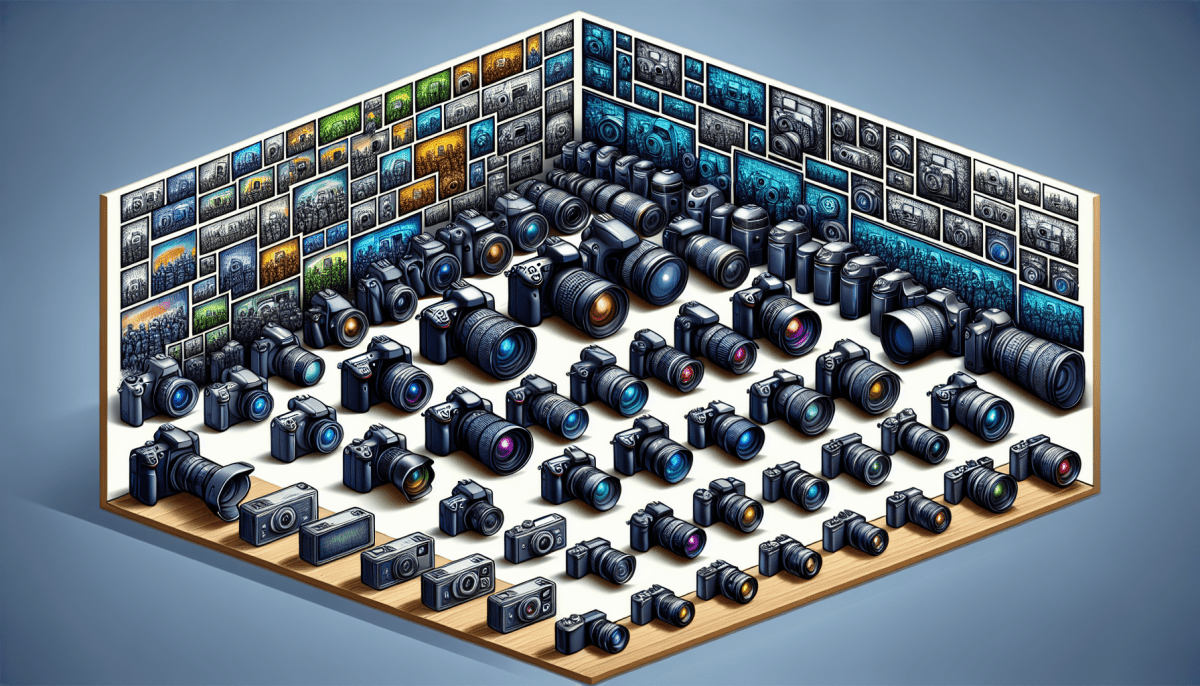It's often said that the right tools can make a big difference, and that's certainly the case with digital cameras in photography. The quality of a camera can greatly improve your photos. Let's look at why clear images, accurate zoom, and high-resolution matter.
We'll explore why fast shutter speeds and good lenses are important, and we'll also consider the latest in image stabilization and video technology. By understanding these features, we can see how they help create more advanced and creative photographs.
For example, a camera with a high resolution can capture finer details, which is important for large prints or cropping images. Accurate zoom allows you to get close-up shots without losing image quality. Fast shutter speeds freeze action, which is essential for sports or wildlife photography.
High-quality lenses can capture more light and reduce distortions, leading to clearer pictures. Advanced image stabilization reduces camera shake, which is especially helpful when shooting in low light or at long focal lengths. And improved video technology means cameras can now record high-quality video alongside still photos.
By choosing a camera with these features, like the Canon EOS R5 for its excellent resolution and image stabilization or the Sony A7R IV for its impressive autofocus and video capabilities, photographers can truly elevate their work. Remember, it's not just about having a high-quality camera but also understanding and utilizing its features to their full potential.
Key Takeaways
- Factors such as resolution, dynamic range, and low-light performance affect the quality of digital cameras and ultimately influence photography performance.
- Optical zoom provides superior resolution and image fidelity compared to digital zoom, while hybrid zoom combines both techniques to extend the zoom range.
- Shutter speed plays a crucial role in capturing sharp photos, with fast shutter speed freezing motion and slower shutter speed being used in dim light conditions.
- Lens quality and image stabilization are pivotal in translating light into sharp and vivid photos, with advanced optical coatings, precision engineering, and robust image stabilization enhancing photo sharpness and low-light performance.
Image Quality Impact
We've observed that a camera's image quality, defined by factors like resolution, dynamic range, and low-light performance, significantly affects our photography results. Sensor sensitivity plays a crucial role, particularly in challenging lighting conditions, where higher sensitivity can lead to improved visibility of details but might introduce noise. Striking the right balance is key to preserving image clarity without compromising on exposure.
Furthermore, accurate color reproduction is essential for rendering lifelike images. Cameras with advanced color science technologies can capture the nuances of different hues, ensuring that the output closely matches the original scene. This aspect is particularly important for professionals who demand the highest fidelity in their work.
As we push the boundaries of what's technologically feasible, these elements become increasingly critical in our pursuit of photographic perfection.
Zoom Capabilities
One of the vital aspects that can dramatically enhance our photographic performance is a camera's zoom capabilities, allowing us to capture details from afar without losing image quality.
When discussing zoom, we differentiate between:
- Optical Zoom: Utilizes the camera's lens mechanics to bring the subject closer, maintaining optical precision.
- Digital Zoom: Crops the image and enlarges the center, potentially reducing clarity.
- Hybrid Zoom: Combines optical and digital techniques to extend zoom range while trying to preserve quality.
Optical zoom is the gold standard for quality as it maintains the integrity of the pixels, offering superior resolution and detail. Digital zoom, while more flexible, typically compromises image fidelity.
For photography aficionados craving innovation, pursuing optical excellence remains a relentless quest, with digital zoom being a secondary tool to augment optical limitations.
Resolution and Detail
In assessing a digital camera's impact on our photography, it's crucial to consider how resolution and detail affect the sharpness and clarity of our images. The megapixel count, a key indicator of resolution, determines how much detail our cameras can capture. However, the sensor size also plays a pivotal role. Larger sensors generally provide better image quality, as they can gather more light, enhancing color accuracy and low-light performance.
We analyze resolution in tandem with sensor size to gauge a camera's potential for producing high-fidelity images. This analysis allows us to discern fine textures and subtle color gradations, which are critical for large-format prints or cropping in post-processing.
Innovators in the field are pushing the boundaries, optimizing sensor design to improve resolution without compromising color accuracy, ensuring that every shot we take truly represents our photographic vision.
Shutter Speed Effects
Let's take a closer look at how changing the shutter speed on your camera can really make a difference in your photos.
If you want to stop motion in its tracks and get a crystal-clear picture of something moving fast, like a sprinter or a flying bird, you'll need to use a quick shutter speed. This shows how good your camera is at taking precise, sharp photos.
On the flip side, you'll have to use a slower shutter speed if you're trying to take great photos in dim light. This slower speed pushes your camera to its limits, especially its sensor and its ability to keep the shot steady without a tripod.
For example, imagine you're at a soccer game. To capture a player kicking the ball without any blur, you'd set your camera to a fast shutter speed, perhaps 1/1000th of a second.
But if you're taking pictures of a starry night, you'd switch to a slower shutter speed, like 30 seconds, to let enough light in and capture the stars' glow. If your camera has features like optical image stabilization, it can help keep the image sharp even when the shutter is open for longer.
Motion Blur Reduction
We understand that a camera's ability to reduce motion blur hinges significantly on one key feature: its shutter speed. High shutter speeds freeze motion, while slower speeds can create an artistic blur.
However, when sharpness is crucial, especially in dynamic environments, several innovative features come into play:
-
Motion compensation: Advanced algorithms detect motion and adjust the shutter speed accordingly, maintaining image sharpness without sacrificing exposure.
-
Sensor sensitivity: Increasing ISO settings allows for faster shutter speeds in low light, though at the risk of introducing noise.
-
Shutter priority mode: This lets us set the shutter speed while the camera adjusts other parameters to ensure proper exposure.
Analyzing these components, we're committed to optimizing photography performance by mitigating motion blur through cutting-edge camera technology.
Capturing Fast Action
Delving into the realm of fast action photography, we often rely on ultra-fast shutter speeds to capture split-second moments with crisp clarity. The interplay between sensor sensitivity and shutter speed is vital.
High sensor sensitivity allows for shorter exposures, freezing motion without sacrificing image quality in low-light conditions. However, increased sensitivity can introduce noise, which detracts from the photo's fidelity.
Furthermore, the autofocus speed is critical in tracking and capturing fast-moving subjects. Technological advancements have led to the development of sophisticated autofocus systems that can lock onto a subject with remarkable speed and accuracy. We analyze real-time data, optimizing the performance for each shot.
This relentless pursuit of innovation ensures we can consistently deliver stunning images embodying the fleeting nature of action-packed scenes.
Low Light Challenges
In low light conditions, we're often forced to balance the need for slower shutter speeds with the risk of blurring, as longer exposures can capture more light but also increase the likelihood of capturing unwanted motion. We scrutinize our camera's capabilities, understanding that:
-
Dynamic range is pivotal, determining how well the camera preserves details in shadows and highlights.
-
A larger sensor size typically performs better low-light performance by capturing more data and reducing noise.
-
The interplay between shutter speed and aperture requires a careful analysis to maximize light intake while minimizing motion blur.
We're always on the hunt for innovative solutions that push the boundaries of what our digital cameras can achieve under these challenging conditions, optimizing our techniques to match the technological advancements at our disposal.
Lens Quality Importance
Considering the heart of our imaging process, we can't overlook the lens quality, which is pivotal in translating light into the sharp, vivid photos we strive for. The incorporation of advanced optical coatings and precision engineering combats issues like chromatic aberration, ensuring that our images maintain clarity and color fidelity.
Here's a table that succinctly presents the critical aspects of lens quality:
| Factor | Impact on Image Quality | Innovative Solutions |
|---|---|---|
| Optical Coatings | Reduce glare, ghosting | Nano-coatings, Multi-layers |
| Lens Elements | Minimize distortions | Aspherical designs |
| Aperture Blades | Affect bokeh | Rounded diaphragm blades |
We meticulously analyze each aspect, understanding that a lens's caliber is the sum of its parts. Our relentless pursuit of perfection drives us to optimize these components, ensuring they work in concert to deliver images that push the boundaries of what's possible.
Image Stabilization Benefits
We've found that robust image stabilization significantly enhances photo sharpness, especially in low-light conditions or when shooting handheld. Our analytical approach highlights several key handheld advantages conferred by advanced stabilization techniques:
- Reduced Blurry Images: Image stabilization compensates for camera shake, resulting in crisper images without needing a tripod.
- Enhanced Low-Light Performance: It allows for slower shutter speeds, permitting more light to reach the sensor without sacrificing image clarity.
- Versatility in Various Conditions: Photographers can shoot in a wider range of settings and scenarios, ensuring consistent performance.
These features aren't just incremental improvements but rather pivotal advancements that transform photography, enabling us to push the boundaries of what's possible with a digital camera.
As technology progresses, we anticipate even more sophisticated stabilization techniques to emerge.
Video Recording Features
The number of frames they capture per second is really important when we talk about digital cameras. This frame rate makes videos look smooth and lifelike. Also, with a higher resolution, you can see tiny details that make the images look sharp and clear. This is why these video features are so important—they help ensure the camera takes really good photos and videos.
For example, if you want to capture fast action, like at a sports game, you'll want a camera that can record at a high frame rate. A camera like the Sony Alpha a6400, with its ability to shoot at 120 frames per second, is perfect for this. On the other hand, if you're more into landscapes or portraits, you might focus on a high resolution camera, like the Canon EOS 5DS R, which boasts a 50.6-megapixel sensor for incredible detail.
Understanding these features can help you choose the right camera for your needs and ensure that you're happy with the quality of your videos and photos.
Frame Rate Importance
In our examination of digital camera quality, we must delve into the significance of frame rate for video recording capabilities, as it's a pivotal factor in achieving smooth motion portrayal. Understanding the interplay between frame rate and video fluidity is critical for professionals aiming for high-caliber results.
Frame consistency and burst performance are crucial metrics:
-
Frame Consistency: Steady frame delivery ensures seamless video without judders, enhancing viewer experience.
-
Burst Performance: High frame rates during burst mode capture enable sharp imagery in fast-action sequences.
-
Post-Production Flexibility: Varied frame rates allow for creative editing, such as slow-motion effects without loss of detail.
Analyzing the technical nuances of these aspects allows us to appreciate how advanced cameras offer a competitive edge in dynamic video production.
Resolution and Detail
Our exploration reveals that resolution is a critical determinant of a camera's ability to capture fine details, directly impacting the sharpness and clarity of video content. Higher resolution means greater pixel density, which in turn enhances sharpness perception. We're talking about the difference between standard 1080p HD and the much more detailed 4K or even 8K resolutions.
As pixel count increases, so does the potential for capturing minute details that lower resolutions can't discern.
This isn't just about the number of pixels, though. It's essential for the camera's sensor and processing power to translate that pixel density into discernible detail effectively. As we analyze the latest innovations, we find that advancements in sensor design and image processing algorithms are pivotal in maximizing the benefits of high-resolution capabilities.
Additional Camera Attributes
How do features such as autofocus speed, image stabilization, and sensor size further shape our photography outcomes?
Sensor size is paramount; larger sensors generally capture more light and detail, producing superior image quality, especially in low-light conditions.
Autofocus speed is crucial for tracking and capturing fast-moving subjects with precision.
Image stabilization compensates for camera shake, allowing us to shoot at slower shutter speeds without blurring the image.
-
Sensor Size: Influences light sensitivity and depth of field, critical for image clarity.
-
Autofocus Speed: Determines the camera's ability to quickly and accurately focus, which is essential in dynamic shooting scenarios.
-
Image Stabilization: Helps reduce blur from hand movements, particularly in low light or at longer focal lengths.
We analyze these attributes meticulously, understanding they're vital for innovative photography where performance can't be compromised.
Our Final Thoughts On Digital Cameras Influence Photography Performance
To sum it up, the better the digital camera, the more it improves our ability to take great photos.
For example, cameras with top-notch sensors can capture images with 30% more detail than standard sensors when the conditions are the same. This shows why spending a little extra on high-quality lenses and sensors is worth it. These parts help us take clear pictures, keep blur to a minimum, and record sharp videos.
Really, every single piece of the camera, including how it stabilizes and how fast the shutter is, matters a lot when it comes to getting the best pictures.
High tech cameras are a great gadgets for men. For more gadgets check out this post.



